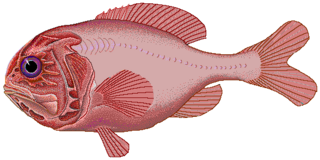
Slimeheads, also known as roughies and redfish, are mostly small, exceptionally long-lived, deep-sea beryciform fish constituting the family Trachichthyidae. Found in temperate to tropical waters of the Atlantic, Indian, and Pacific Oceans, the family comprises about 50 species in eight genera. Slimeheads are named for the network of muciferous canals riddling their heads.
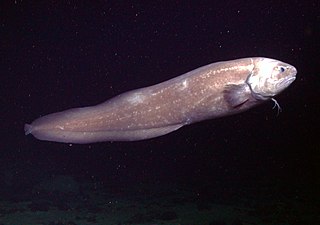
The cusk-eel family, Ophidiidae, is a group of marine bony fishes in the Ophidiiformes order. The scientific name is from the Greek ophis meaning "snake", and refers to their eel-like appearance. True eels diverged from other ray-finned fish during the Jurassic, while cusk-eels are part of the Percomorpha clade, along with tuna, perch, seahorses and others.
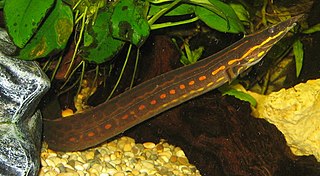
The fire eel is a relatively large species of spiny eel. This omnivorous freshwater fish is native to Southeast Asia but is also found in the aquarium trade. Although it has declined locally due to overfishing, it remains common overall.
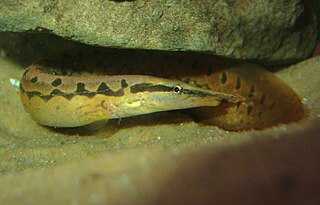
The zig-zag eel, also known as the Baim,tire-track, tire-track spiny- or marbled spiny eel, is a species of freshwater ray-finned fish in the family Mastacembelidae. It is native to the riverine systems of the Indian Subcontinent, Sri Lanka, Malaysia,Thailand, Vietnam, Cambodia, Indonesia, and other parts of South and Southeast Asia. The species was initially described as Macrognathus armature. Other common names for this popular captive species include the leopard spiny eel and white-spotted spiny eel.

Nemipterus virgatus, the golden threadfin bream or yellowlipped threadfin bream, is a species of marine ray-finned fish belonging to the family Nemipteridae, the threadfin breams. This species is found in the Western Pacific Ocean.

Cephalopholis fulva, the coney or the butterfish, is a species of marine ray-finned fish, a grouper from the subfamily Epinephelinae which is in the family Serranidae which also includes the anthias and sea basses. It is found in the western Atlantic. It is associated with reefs and is a quarry species for commercial and recreational fisheries. It can be found in the aquarium trade.

The sailfin snapper, blue-lined sea bream or blue-lined sea perch is a species of marine ray-finned fish, a snapper belonging to the family Lutjanidae. It is native to the Indo-Pacific region. The sailfin snapper is targeted in mixed-species fisheries throughout its range. In areas such as the Philippines it is known to be overfished, while in others, for example Palau, pressure is lighter. It is caught predominantly using handlines and bottom trawling. The juveniles appear in the aquarium trade. It is currently the only known member of its genus.
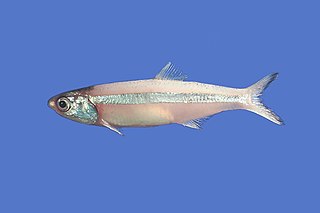
Anchoa hepsetus, commonly known as the broad-striped anchovy, is a species of ray-finned fish in the family Engraulidae. It grows to be about 15 cm (6 in) long. The broad-striped anchovy is found in the west Atlantic along the North American coast from Nova Scotia and the Maine coast scarcely, and abundantly from the Chesapeake bay to the West Indies and Uruguay. It is found most commonly in shoals along coastal waters, as deep as 73 m although mostly found in water shallower than this. The broad-striped anchovy spawns in spring. Their eggs are pelagic and hatch within 48 hours at regular spring temperatures. At young ages, it eats copepods, but as the fish ages, its diet begins to consist of other small crustaceans, molluscs, and worm larvae. It is an important food staple for large commercial fishes, such as the American seatrout. It is commonly eaten by birds. It is elongate with large eyes and protuberant snout, large mouth and underslung jaw. Its anal fin is quite short, and its front fin lies beneath the end of the dorsal fin. It is grey-green with black dots, but its notable feature is its silvery stripe from head to tail.

The longnose shiner is a species of ray-finned fish in the genus Notropis.
Vinciguerria lucetia is a species of marine ray-finned fish in the genus Vinciguerria known by the common name Panama lightfish. It is a small bioluminescent fish, with two rows of tiny photophores along its body. It is very abundant in the tropical Indo-Pacific where it makes large vertical migrations each day.

Upeneichthys vlamingii, the blue-spotted goatfish, southern goatfish, black-striped goatfish, blue-striped red mullet, southern red mullet or western red mullet, is a species of marine ray-finned fish, a goatfish from the family Mullidae native to the coast of southern Australia.

Blennophis striatus, the striped klipfish, is a species of clinid found in the subtropical waters of the Atlantic Ocean from Saldanha Bay to East London, South Africa where it can be found in the subtidal zone as well as inhabiting tidepools. This species can reach a maximum length of 17.5 centimetres (6.9 in) TL.

Anchoa mitchilli is a species of ray-finned fish in the family Engraulidae, the anchovies. Its common names include bay anchovy and common anchovy. It is native to the western Atlantic Ocean and the Gulf of Mexico. It is one of the most common fish species along the coastlines of the western Atlantic.

The band cusk-eel is a fish species in the family Ophidiidae. Widespread in the Western Atlantic from North Carolina, United States, and northern Gulf of Mexico to southeastern Brazil. Absent from The Bahamas. Marine reef-associated tropical demersal fish, up to 30 cm (12 in) long.

The blue blanquillo, also known as the banded blanquillo, striped blanquillo, false whiting, sand tilefish or eye of the sea, is a species of marine ray-finned fish, a tilefish belonging to the family Malacanthidae. It is found in the Indo-Pacific.

Sebastes elongatus, the greenstriped rockfish, striped rockfish, strawberry rockfish, poinsettas, reina or serena, is a species of marine ray-finned fish belonging to the subfamily Sebastinae, the rockfishes, part of the family Scorpaenidae. It is found in the northeastern Pacific Ocean.
Elacatinus colini, the Belize sponge goby, is a species of goby native to the Western Central Atlantic Ocean, near Belize and Honduras.

The banded rudderfish, also known as the slender amberjack, banded mackerel or shark pilot, is a species of ray-finned fish from the family Carangidae, the jacks and pompanos from the western Atlantic Ocean.

Decodon puellaris, the red hogfish, is a species of marine ray-finned fish from the family Labridae, the wrasses, from the western Atlantic Ocean.

Pentapodus vitta , the Western whiptail, Western butterfish, black stripe butterfish, striped whiptail or Western threadfin bream, is a species of marine ray-finned fish belonging to the family Nemipteridae, the threadfin breams. This fish is found in the Eastern Indian Ocean.



















